 |
 |
 |
 |
 |
|
Camber Plates |
|
Do you need Camber-Caster plates plates
|
|
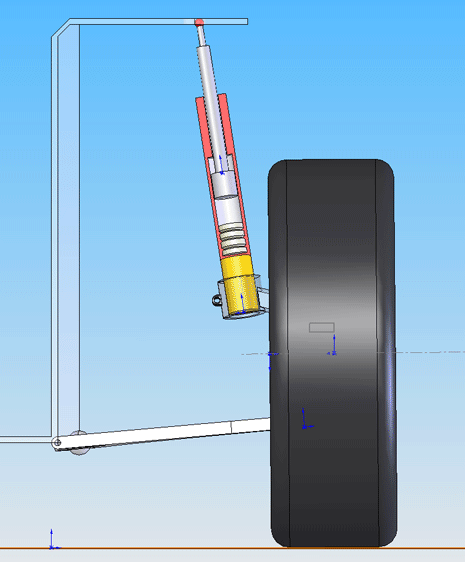
Many Hondas use McPherson struts, only one of the three
alignment settings toe can be adjusted. For high performance use, the
ability to adjust camber and caster is desirable as well, particularly
on the front suspension. Camber-caster plates provide these adjustments,
and usually replace the upper mounting and bushing at the top of the
fender well where the strut rod is connected to the body.
Camber is the amount the top of the tire leans inward or outward in
comparison to the bottom of the tire with the tires straight ahead. If
the wheel leans inward at the top, it has negative camber. If it leans
outward at the top, it has positive camber. The measurement is made in
degrees and minutes. Most Hondas will work better under
hard cornering with negative camber. By leaning the wheel inward at the
top, the bottom is leaned outward. This outward tilt where the tread
meets the pavement helps resist tire-sidewall rollover, keeping more of
the tread in contact with the road and increasing its cornering
traction. Looked at another way, it gives the tire a head start against
body and tire roll. The disadvantage of negative camber,
particularly in great amounts, say, more than one degree, is that tire
wear will increase (on the inside edge) as the car is driven under
normal conditions. Also, the car may dart when it encounters different
surfaces from side to side, like running through a puddle with one side
of the car.
Caster is hard to visualize on a car because of the links, arms and
struts that make up the suspension. But, using a motorcycle as an
example, think of the front forks and how the bottoms of the forks are
ahead of the tops. The more the forks are leaned forward at the bottom,
the greater the caster. The result when the handlebars are turned is
that the bottom of the tire leans outward.
The alignment of car suspension components results in the same effect.
The more the wheel on the outside of a corner is turned, the more the
bottom of the tire leans outward. By adding more caster this effect is
increased, again helping the tire tread to keep full contact against the
road. Additionally, more caster increases the car's resistance to
wandering when being driven straight, and increases the self-centering
action of the steering wheel. The disadvantage Camber-castor plates
allow adjustment of front suspension alignment beyond that allowed by
the stock components. Generally, toe is the only adjustment that can be
made.
|
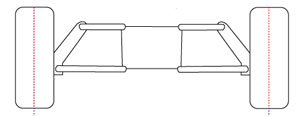 |
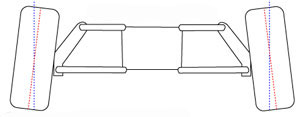 |
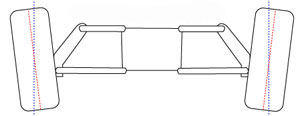 |
For a zero setting, the tire/wheel assembly is in the exact
vertical position or perpendicular to the ground.
Camber : The inward or outward tilt of the tire/wheel assembly. This angle
is measured from a true vertical line, perpendicular to the ground. A
tire/wheel assembly that is tilted outward at the top is considered to have
Positive camber. While a tire/wheel assembly tilted inward at the top,
displays Negative camber. |
Effects of negative camber : negative camber can be used to
improve the handling of a vehicle. A setting of 1/2° negative on both sides
of a street car will improve cornering without affecting tire life greatly.
This negative setting compensates for the slight positive camber change of
the outside tire due to vehicle roll, thereby allowing a flatter tire
contact patch during cornering. Excessive negative camber wears the inside
of the tire and similar to positive camber, it can cause wear and stress on
suspension parts. |
Effects of positive camber : results in a dynamic loading
that allows the tire to run relatively flat against the road surface.
Positive camber also directs the weight and shock load of the vehicle on the
larger inner wheel bearing and inboard portion of the spindle rather than
the outboard bearing. Positive camber in moderation results in longer
bearing life, less likely sudden load failure, and as a side benefit, easier
steering. Excessive positive camber wears the outside of the tire and can
cause wear to suspension parts such as wheel bearings and spindles. |
|
. |
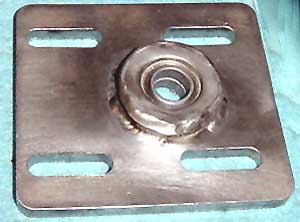 |
The spherical bearings are soft brass. The camber plates were plasma cut
from 1/4inch steel plates. Adrians model used to design the plates to move
inwards and back along a linear line. The spherical bearing is held in by a
welded top, and the bottom traps the bearing using a inside c-clip. The
rears are adjustable for camber only. |
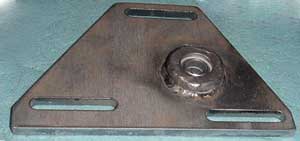 |
|
|
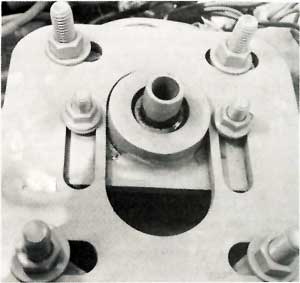 |
Camber-castor plates allow adjustment of front suspension alignment beyond
that allowed by the stock components. Generally, toe is the only adjustment
that can be made.
This one on the left is from A-T Engineering, for a 1200 Civic.
The one on the right differs mainly in attachment and is installed on George
Cleveland's 1200 Civic. In addition to adding adjustments to the cars, these
plates also attach to the strut rods with spherical bearings. These bearings
replace the less precise synthetic rubber bushings that are stock. |
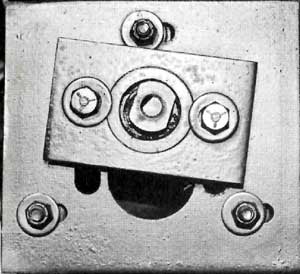 |
|
. |
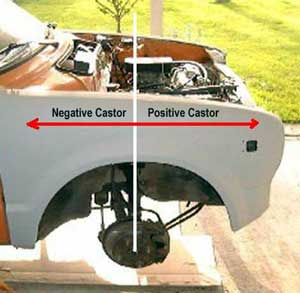 caster
: The forward or rearward tilt of the projected steering axis from true
vertical, as viewed from the side. This line is formed by extending a line
through the upper and lower steering knuckle pivot points. For vehicles with
front control arms, visualize the line extending through the upper and lower
ball joints. Caster is always viewed from the side of the vehicle. When the
upper pivot point is rearward of the lower pivot point, caster is positive.
If the upper pivot is forward of the lower pivot point, caster is negative.
When the two points are straight up and down from each other, the caster is
zero. Caster is not a normal tire wearing angle and is used as a directional
control for stability and steering return ability. Caster effect is
necessary so that the load of the vehicle is "carried" through the steering
axis line formed on the upper and lower pivot points. caster
: The forward or rearward tilt of the projected steering axis from true
vertical, as viewed from the side. This line is formed by extending a line
through the upper and lower steering knuckle pivot points. For vehicles with
front control arms, visualize the line extending through the upper and lower
ball joints. Caster is always viewed from the side of the vehicle. When the
upper pivot point is rearward of the lower pivot point, caster is positive.
If the upper pivot is forward of the lower pivot point, caster is negative.
When the two points are straight up and down from each other, the caster is
zero. Caster is not a normal tire wearing angle and is used as a directional
control for stability and steering return ability. Caster effect is
necessary so that the load of the vehicle is "carried" through the steering
axis line formed on the upper and lower pivot points.
Effects of positive caster : positive caster promotes directional stability,
however, excessive positive caster can cause two problems. The first is that
excessive caster will cause a high level of road shock to be transmitted to
the driver when the vehicle hits a bump, etc. The second problem is that a
tire/wheel assembly with positive caster has a tendency to toe inward when
the vehicle is being driven. If one side has more positive caster than the
other, this causes it to toe inward with more force than the other side.
This will cause a lead or pull to the side with least amount of positive
caster.
Effects of negative caster : a vehicle with negative caster will have a
tendency to be easier to steer but will lack directional stability. It is
also affected by any road surface variation such as small road
irregularities or bumps. With the point of load pushing the tire along
(negative caster), any bumps or road irregularities which are encountered
have a tendency to immediately affect directional stability and vehicle
handling. |
|
|
|
|
 |
 |
 |
 |
|
 |

